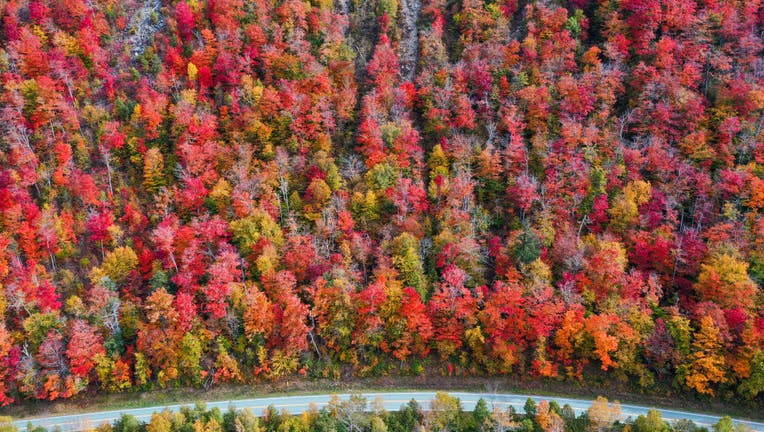Autumnal equinox 2023: Fall officially begins this weekend

Aerial view of colorful fall foliage is seen in Newark of Vermont, United States on October 12, 2021. (Photo by Tayfun Coskun/Anadolu Agency via Getty Images)
This week brings the official start of fall, a farewell to warmer weather in the Northern Hemisphere to make way for fall foliage and all things pumpkin spice.
The autumnal equinox of 2023, also known as the September equinox or fall equinox, arrives on September 23, according to the Farmer’s Almanac.
The date marks the start of fall in the Northern Hemisphere and spring in the Southern Hemisphere — and the equinox occurs at the same moment worldwide.
What time is the 2023 fall equinox?
The autumnal equinox officially arrives at 02:50 a.m. ET on Saturday.
RELATED: Wendy’s launches Pumpkin Spice Frosty just in time for fall
During the equinox — which occurs twice per year — the sun crosses what’s known as the "celestial equator," or an extension of Earth’s equator line into space, the Farmer’s Almanac explains.
The autumnal equinox happens when the sun crosses the equator from north to south. The vernal equinox, or the start of spring, happens when it moves from south to north.
The full moon that happens nearest to the fall equinox is known as the "Harvest Moon." This year’s Harvest Moon will peak in the early morning hours of September 29.
Unlike other full moons, the Harvest Moon rises around sunset for several evenings in a row, "giving farmers several extra evenings of moonlight and allowing them to finish their harvests before the frosts of fall arrive," the Farmer’s Almanac states.
Autumn equinox meaning
The word "equinox" comes from the Latin word aequus, which means "equal," and nox, which means "night," according to the Farmer’s Almanac.
RELATED: Why fall season should actually begin on September 1
On the equinox, day and night are roughly equal in length.
What is "meteorological fall?"
While fall doesn’t officially start until mid-September on the autumnal equinox, known as "astronomical fall," there is also a "meteorological fall" that began on Sept. 1.
Meteorologists divide the year up into four seasons based on the annual temperature cycle, while astronomers determine the seasons by the Earth’s tilt, according to the Farmer’s Almanac.
For example, fall for meteorologists begins Sept. 1 through Nov. 30. Winter starts on Dec. 1 and ends on the last day in February.
In comparison, fall for astronomers (and likely on your calendar) begins with the autumnal equinox and winter begins with the winter solstice.
When will the leaves start to change colors?
As this part of the world moves into fall, temperatures won't be the only thing changing. The transition also marks the start of the changing of the leaves.
The annual fall foliage is highly contingent on the location and, in some areas, can start as early as late September and peak in either October or November, according to FOX Weather.
While the colors depend on the chlorophyll in the leaves, weather conditions during the summer and early fall can play a big role in how extravagant the sights are. The lack of chlorophyll can help reveal the sought-after yellow, orange and red colors, which usually are bountiful during rainier periods.
Large deviations from normal precipitation either on the dry side or the wet side can greatly impact the foliage season.
"The drought is a big factor this year. Where the drought is worse, the peak is going to be really quick, really fast, and the leaves are going to come down," Yankee Magazine fall foliage expert Jim Salge told FOX Weather.
"There are areas up along the Canadian border, all across the northern tier of the country, from Minnesota to Michigan to the Adirondacks, where the drought is a lot less severe. And we expect the colors to be bright and early, especially if we get some cold snaps coming down in September."
Experts say during a drier season, leaves tend to turn colors earlier and will end the process quicker than in years with more precipitation.
Most of the country will be in peak foliage season during October. In the lower 48, communities along the Canadian border will be the first to reach this status.
The peak foliage dates vary each year but usually fall within a couple of weeks of past episodes.
Mid-November is considered to be one of the latest dates to see a significant changes in leaves. Areas outside of the colored zones do not usually have a significant amount of trees that lead to brilliant colors.
Kelly Hayes FOX Weather contributed to this story.

